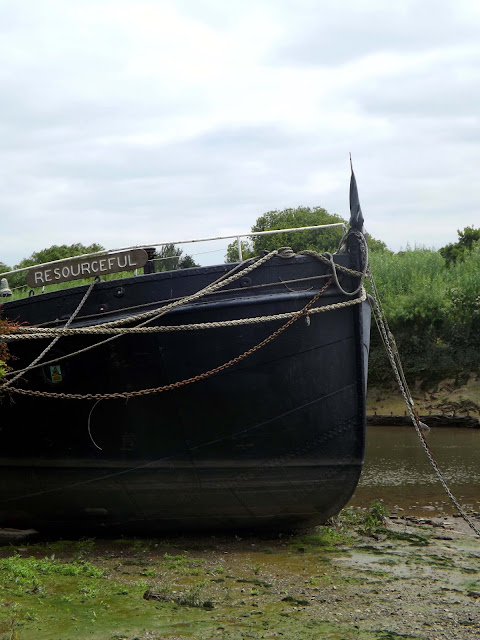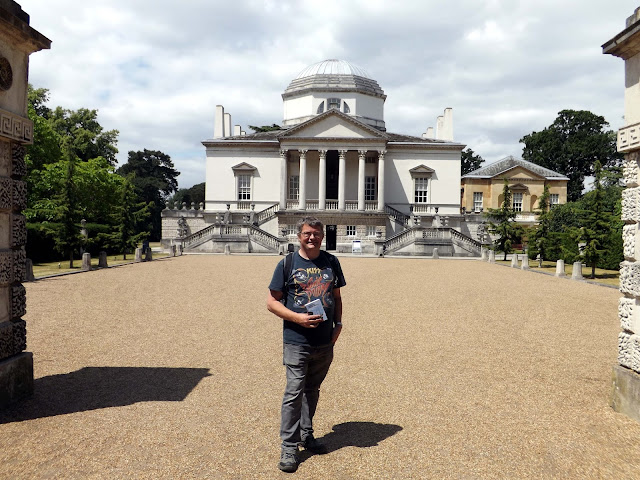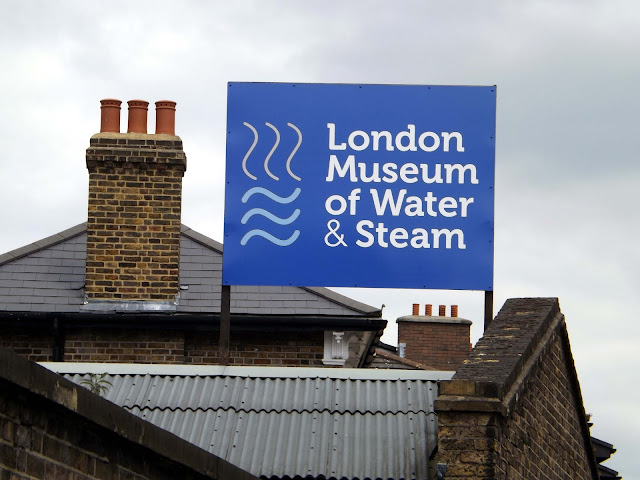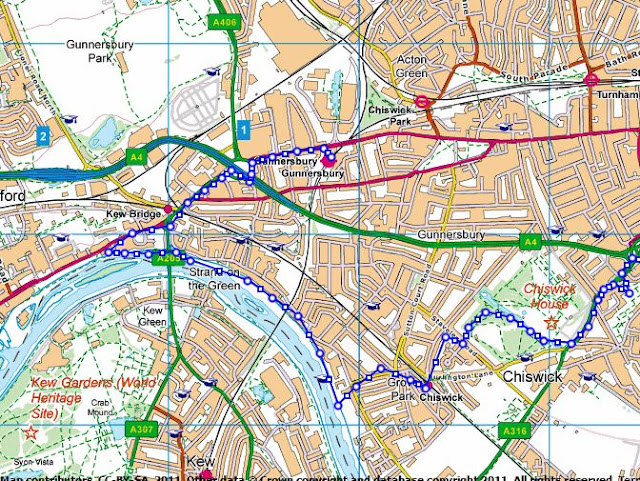I arrived at Hammersmith Bridge. The original bridge was built in the 1820s by William Tierney Clarke and was the first suspension bridge in London. His efforts were in vain as the bridge was unable to cope with the demands placed on it in terms of traffic and thousands of spectators watching the Oxford and Cambridge boat race.It was replaced 60 years later.
The second and current bridge was designed by Sir Joseph Bazalgette and was opened by the Prince of Wales in 1887. Bazalgette was best known for designing London's first modern sewage system that helped London be free of pollution and Cholera. The central span of the bridge is 423ft long and has been targeted by the IRA 3 times. The first in 1939 when a local hairdresser Maurice Childs was passing by and saw the bomb. He bravely picked it up and threw it in the river.Again in 1996 when 2 of the most powerful semtex bombs planted in Britain failed to explode, and another in 2000.
I walked below the bridge onto The Thames Path and turned right onto Lower Mall. Where there are numerous rowing and sailing clubs.
 |
| View back to the Hammersmith Bridge. |
I pass the headquarters of the British Rowing Organisation at no 6. They are in overall charge of the sport in the UK and responsible fro the success of the GB rowing team at The Olympics and World Championships in recent years.
I pass The Blue Anchor first licensed in 1722 and The Rutland Arms next door. The Blue Anchor is where Gweneth Paltrow and John Hannah have a drink in the 1998 film Sliding Doors.It is also where Gustav Holst composed The Hammersmith prelude & Scherzo.
I pass the Furnivall Sculling club and Furnivall Gardens, both are named after the clubs founder Dr Frederick James Furnivall (1825-1910). Furnivall was a philologist who helped establish the Oxford English Dictionary. He also loved his rowing and was still rowing from here to Richmond and back until just before his death at the age of 85.
Furnivall disliked the Amateur Rowing Associations discrimination against women and working men. Women couldn't join because they couldn't abide by the strict amateur ethos. Furnivall set up a new club here in 1896 principally for women rowers having already formed The National Rowing Association designed to encourage working men to take part in the sport. It has been suggested that Kenneth Grahame , the author of The Wind In The Willows based the character Ratty on his good friend Furnivall- both certainty liked 'Messing about in boats'.
The gardens were built on the site of bombed buildings destroyed by The Luftwaffe during World war II. They also lie on what used to be the Hammersmith Creek, an outflow of the Stamford Brook,one of London's lost rivers.
I stopped off here for a London Pride Ale watching the river folk go by.
I continue on past The Dove what is now Upper Mall. Again back alongside The Thames.
I pass a home with a plaque commemorating Andy Holmes MBE (1959-2010) a double world champion rower.He went learned to row here on the river and went on to win two gold medals in the sport at the 1984 and 1988 Olympics. He retied from rowing in 1990 and was killed by the waterborne disease feared by all regular river users Weils Disease.
 | |
| The London Corinthians Sailing Club dinghy racing starting box. |
Linden House (no 60 Upper Mall) was originally built for a wealthy merchant and dates from 1733. The Sons Of The Thames formed in1886 moved in Linden House.
 |
| The skies were busy with aircraft heading for nearby Heathrow Airport. |
Again I the path veers away from The Thames and I stop for a Cornish Tribute ale at The Black Lion Public House. This dates from the late 18th century and is said to be haunted by The Hammersmith Ghost. The story is that in 1803 a local woman was scared to death by the sight of a ghost thought to be the troubled spirit of a man who committed suicide nearby shortly before. A few months later a local man Francis smith went out with his blunderbuss looking for the ghost. He came across a local bricklayer named Thomas Millwood who was covered in white dust. Smith mistook Millwood for the Hammersmith Ghost and shot him. Millwood was carried to the Black Lion where he died. In a cruel twist of fate, it is said he haunts the pub to this day. Smith was found guilty of murder and was sentenced to just one year in prison.
The pub also is associated with the pub game of skittles which was popularised by AP Herbert. Herbert was a regular at the pub who lived nearby.
 |
| Skittle Alley Coffee and Pantry |
AP Herbert resided at 12-13 for 50 years. Apart from popularising skittles,writing books and serving as a MP,Herbert also found time to make important contributions to the reform of the divorce laws.
I continue onto Chiswick Mall, where the most expensive properties sell for10 million plus. I am now leaving Hammersmith and am entering Chiswick. Chiswick's name is derived from Old English for 'Cheese Farm'. Probably a trade carried out in the medieval meadows beside the river.
 |
| Private gardens beside the river. |
It remained a village until the next century where expanding London engulfed it and the fishing industry died out due to pollution.
 |
| View across to an uninhabited island called Chiswick Eyot( Neyot pronounced 'eight') |
 |
| Chiswick Eyot |
I pass Fullers Brewery, I detoured to head up to the shop but it was closed due to stock taking. Disappointed I return to the path. I will return for a tour of the brewery.
Bedford House was home to actor Michael Redgrave(1908-1985) after buying it in 1945. He lived there for 10 years with his wife and children.
 |
| . |
 |
| Old signage of Lambs Brewery (rival of Fullers) brewing ended at Lambs in 1922. |
St Nicholas’s Church on Church Street in Chiswick is reputedly haunted by two of Oliver Cromwell’s daughters and there is even a legend associated with the church suggesting that the Lord Protector himself may have finally found peace there.
Though the current building of St Nicholas's Church designed by , John Loughborough Pearson dates from around 1882 - 1884, there has been a church on this site since 1181 and the tower dates from between 1416 and 1435. In the 7th Century a pagan site on the site was converted to Christianity and this was still in existence during Edward the Confessor’s reign.
Whether Cromwell is actually buried at St Nicholas’s Church is unknown, as is whether his two daughters haunt the building and grounds as I have not found any witness reports. Other possible locations for the location of his body include, obviously the burial pit at Tyburn, the Cromwell vault in Newburgh Priory and under the Naseby battlefield.
The tomb of William Hogarth (1697-1764).William Hogarth was an English painter, printmaker, pictorial satirist, social critic, and editorial cartoonist who has been credited with pioneering western sequential art.
 |
| Tomb of Philip James De Louthrebourg(1740-1812). a Franco-British painter who became known for his large naval works, his elaborate set designs for London theatres, and his invention of a mechanical theatre called the "Eidophusikon". He also had an interest in faith-healing and the occult and was a companion of Cagliostro. |
It is also said to be haunted by a tall man wearing a large wide brimmed hat who rearranges the pictures.
I walk on and out onto Hogarth roundabout.
The Hogarth Roundabout is one of London's best known road junctions. It is situated at the junction of the A316 Great Chertsey Road and the A4 Great West Road in Chiswick.The Hogarth Roundabout is named after the eighteenth-century painter William Hogarth who lived in nearby Hogarth's House.
I take the subway and out onto the A4 towards Hogarths House.
After a horrible section of the walk along the noisy A4, I reach Hogarths House.
Hogarth's House contains an extensive collection of prints and engravings by the artist William Hogarth. The house was his country home and has been restored to tell the history of his life and the building. William Hogarth was a artist and engraver(1697-1764) who purchased the house as his second home in 1749.The house was surrounded by open fields,The garden still had the mulberry tree that his wife used the fruits to make tarts.
I left Hogarths House and headed back up the A4 to reach Chiswick House.
Chiswick House is one of the finest examples of neo-Palladian design in England. Inspired by the architecture of ancient Rome and 16th Century Italy, the third Earl of Burlington built the house as a homage to Renaissance architect Palladio.
Never intended as a private residence, Chiswick House remains a bold architectural experiment; a showcase for art collections, and a venue for entertaining.
 |
| Chiswick House Conservatory |
Chiswick House is the first and one of the finest examples of neo-Palladian design in England.
Created by the third Earl of Burlington, who was inspired on his
grand tour by the architecture of ancient Rome and 16th century Italy,
Chiswick House is a stunning homage to the work of Renaissance architect
Palladio.Completed by 1729, the villa, which echoes classical temple design, was never conceived as a private residence. It is instead, a bold architectural experiment by Burlington, a grand pavilion where he could display his art and book collection and entertain small groups of friends.
During his travels Burlington met the architect William Kent and invited him to collaborate on the design of the villa. No expense or creativity was spared on the interior and Kent designed the luxurious and colourful velvet rooms with red, green and blue velvet walls, that interconnect with a magnificent domed central saloon.
Today, the Blue Velvet room and Upper Tribunal have been expertly restored and a future phase of the restoration programme will see the other main rooms returned to their original splendour.
The history of the house is complex and intriguing and there are a wealth of stories to tell and works of art to admire.
 |
| A Grey Heron |
I exit through The Burlington Lane Gate exit pass some youths smoking cannabis by the monument out onto the road until I reach St Paul's Church,built in 1872. I took a wrong turn here and turnt left at the end of the road instead of right. I only walked a short distance before realising my mistake and was soon back on track and after crossing the train lines and down a road I was back by the river once again.
A small fountain dated 1880 funded by an individual request in conjunction with The Metropolitan Drinking Fountain an Cattle Trough Association,founded to provide the public,cattle and horses with free drinking water.
 |
| The District line and London Overground both cross the river on the railway bridge erected in 1869 between the City Barge and Bull's Head pubs. |
A footpath runs along the bank of the river, overlooked by numerous imposing 18th-century houses and local pubs, and, being a low part of the Tideway which has been narrowed with embankments on both banks, is flooded at spring tides; property flooding is rare but has occurred to basements and other storeys before the construction of the Thames Barrier.
I pass the Bulls Head .The Bulls Head is a delightful 18th century tavern once used by riverboat and barge captains to arrange crews and cargoes. Licensed since at least 1722, there has been an inn on the site for over 400 years, and legend has it that Oliver Cromwell, after whom Oliver’s Island opposite is named, once used the inn, although the evidence for this is disputed.
 |
| A couple fishing with nets in The Thames, not sure what for though. |
I pass under Kew Railway bridge and pass The City Barge. The City Barge is a historic 14th century public house with a wealth of history behind it and is situated on the Thames riverside, nestled in the picturesque area of Strand on the Green, Chiswick.Internally, the building has retained much of the architectural detail and period fixtures and fittings, including original Victorian paneling and three open fires. A striking reclaimed nineteenth century bar provides a natural focal point for the upper level and some quirky touches including rare bird taxidermy, vintage games, and a metre-long Thames Barge.
The pub features in The Beatles film 'Help!' when the band find refuge in the pub after being chased by Klang. Ringo orders 'Two lagers and lime and two lagers and lime'. Filming took place here on 24th April 1965. Its popular with Ant & Dec whose management company is nearby. The pub was partly destroyed by a parachute mine in WWII and rebuilt.
 |
| A house with its own flood door,evidence of its vulnerability to flooding. |
 |
| Mini raised doors on properties to combat flooding. |
I continue past The Bell & Crown PH on The Strand.Licensed since 1787 and owned by Fullers Brewery since 1814. It is rumored to have been used by smugglers in the past and has a residential ghost that turns on the pumps during the night.
I now reach Kew Bridge.The present bridge, which was opened in 1903 as King Edward VII Bridge by King Edward VII and Queen Alexandra, was designed by John Wolfe-Barry and Cuthbert A Brereton. It was given Grade II listed structure protection in 1983.
I walk on under the bridge and along a little further before heading back onto the road and head towards the Kew Bridge Steam Museum.
 |
| Kew Bridge Steam Museum |
I enter the London Museum Of Water & Steam,but decided not to go in, the admission price and the fact that time was running away from me dissuaded me. I looked around the small gardens outside and before heading off.
I walked past Kew Rail Station and headed off to Gunnersby Tube Station a little way away as its tube connections back home was easier. A 6 mile walk all in all and a great day out.

























































































Awesome photo's,trip report and walk choice.
ReplyDeleteCheers Max
ReplyDeleteGreat trip report and pictures! I work in Chiswick and I really enjoy this neighborhood. As far as I know Fullers Brewery can be visited by appointment only, and only within groups, with a guide (most often a CAMRA volunteer) who will show you how beers are being made on the premises.
ReplyDeleteGlad you enjoyed it Teddy anx thanks for the info. I'll look into it
Delete